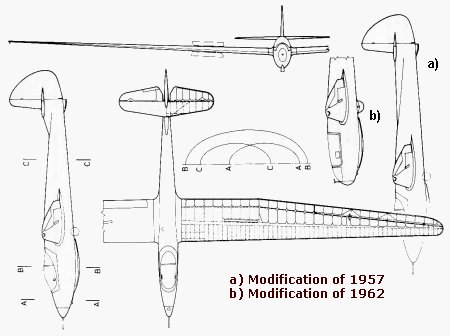| Type designation: | M-30-C/1s |
|---|---|
| Name: | Super Fergeteg |
| Designer: | Designers of the Hungarian Aeronautical Association |
| Class: | High performance |
| General arrangement: | Shoulder wing, sinle seat, skids and wheel dolly, traditional tail unit |
| Crew: | 1 |
| First flight: | February 1954 |
| Manufacturer: | Central Workshop of Hungarian Aeronautical Association, Dunakeszi |
| Number of built: | 1 |

.jpg)
.jpg)

| Dimensions: | |
|---|---|
| Wing: | |
| Span, m: | 18 |
| Area, m2: | 18,96 |
| Aspect ratio: | 17,1 |
| Chord (root), m: | 1,4 |
| Chord (tip), m: | 0,35 |
| Airfoil (root), m: | NACA 23012 |
| Airfoil (mid-span), m: | NACA 23012 |
| Airfoil (tip), m: | NACA 0009 |
| Dihedral, degree: | 3 |
| Sweep, degree: | ? |
| Washout: | Aerodynamic and -2 degree geometric |
| Aileron: | |
| Span, m: | 4,17 |
| Mean chord, m: | 0,3 |
| Total area, m2: | ? |
| Balancing: | Inner mass |
| Flap: | |
| Type: | None |
| Airbrakes: | |
| Type: | Göppingen |
| Position (upside/downside): | u/d |
| Total area, m2: | 0,46 |
| Position, % of chord: | 0,458 |
| Horizontal stabilizer: | |
| Span, m: | 2,55 |
| Area, m2: | 1,47 |
| Elevator: | |
| Span, m: | 2,55 |
| Area, m2: | 0,7 |
| Airfoil: | NACA 0009 |
| Balancing: | Mass |
| Trim: | Yes |
| Vertical stabilizer and rudder: | |
| Total area, m2: | 1,3 |
| Rudder area, m2: | 0,7 |
| Balancing: | None |
| Fuselage: | |
| Length, m: | 8,1 |
| Width, m: | ? |
| Height: | ? |
| Cross section, m2: | ? |
| Landing gear: | |
| Type: | Original version: Nose and aft skid, wheel dolly; 1962 version: retractable wheel |
| Wheel diameter, m: | 0,42 |
| Masses: | |
| Wing, kg: | ? |
| Fuselage, kg: | ? |
| Tail unit, kg: | ? |
| Empty glider, kg: | 390 |
| Gross, kg: | 500 |
| Ballast, kg: | - |
| Wing loading, kg/m2: | 26,4 |
| Speeds: | |
| VNE, km/h: | 250 |
| Max. speed with open airbrakes, km/h: | 250 |
| Max. aerotow speed, km/h: | 130 |
| Max. winch speed, km/h: | 100 |
| Max. speed in rough air, km/h: | ? |
| Stall speed, km/h: | ? |
| Performance: | |
| Min. sink, m/s (at gliding speed, km/h): | ?/? |
| Best L/D (at gliding speed, km/h): | ?/? |
| Start methods: | Winch, Aerotow |
Origin of data and 3-view drawing:
Jereb Gábor: Magyar vitorlázó repülőgépek, Műszaki Könyvkiadó, 1988, Budapest
(Gábor JEREB: Hungarian Gliders, Technical Publishing House, 1988, Budapest)
Gábor FEKECS E-mail: fekecs.gabor@t-online.hu